Olivia Newton-John
publicity shoot for the movie Toomorrow
Soho Square, London, July 1970
Wednesday, January 31, 2018
Monday, January 29, 2018
The Wizard's Venom by Frank Brunner
'The Wizard's Venom'
by Frank Brunner
from Star*Reach Greatest Hits, 1979
Featuring some fine graytone illustration, this comic from Frank Brunner offers a satirical take on the 'barbarian hero' theme............
by Frank Brunner
from Star*Reach Greatest Hits, 1979
Featuring some fine graytone illustration, this comic from Frank Brunner offers a satirical take on the 'barbarian hero' theme............
Labels:
The Wizard's Venom
Friday, January 26, 2018
Book Review: Stopwatch
Book Review: 'Stopwatch' edited by George Hay
2 / 5 Stars
‘Stopwatch’ (224 pp) was published by the New English Library in November 1975. The cover art is by Tim White.
In his Introduction, editor George Hay announces that the theme uniting the stories (all of which were written exclusively for this anthology) is ‘subversion.’
My capsule summaries of the contents:
The Protocols of the Elders of Britain, by John Brunner: a technician assisting with repairs to the UK Ministry of Defense super-computer makes some unsettling discoveries. One of the better entries in the anthology.
Are Your Home Grown Vegetables Radioactive ? by Kathleen Brennan: satire about governmental oversight of healthy eating.
Ash, Ash, by Robert Holdstock: a man is one of the galaxy’s most heinous mass-murderers…..or is he ? Author Holdstock tries to do ambitious things with this story, but I found it unconvincing.
All We Have on This Planet, by A. E. Van Vogt: editor Hay attempts to defuse criticism at having an entry by Van Vogt in this anthology by stating that it addresses the theme of subversion with skill and style...........?! The story, which has something to do with a writer confronting an alien invasion, is plotless and vague.
EA 5000: Report on the Effects of a Riot Gas, by Ian Watson: in a near-future UK riven by anarchy and social strife, a team of Ministry of Defense staffers strategize a humane way to incapacitate rioters. Watson’s setting serves as a believable extrapolation of the economic turmoil gripping Britain in the mid-70s. This is another of the better entries in the anthology.
Intracom, by Ursula K. Le Guin: an overly labored satire of ‘Star Trek’; it gradually emerges that most of the crew is female, rather than male. This presumably is the ‘subversive’ element of the story. A reminder that the late Le Guin could produce some mediocre material.
A Bedtime Story, by Douglas Letts: faux-historical treatise about a UK company that designs and manufactures robots. Too dull and long-winded to be effective.
The Invisible Men, by Christopher Priest: the Prime Minister and his American minder try to converse on matters of import. Unremarkable.
Now is Forever, by Edward Allen: Neils Jorgsen becomes the world’s first man to Jack In to a supercomputer; in so doing, he receives a revelation about the Oneness of All Living Things. A slight tale, but one that perhaps deserves mention as a proto-Cyberpunk tale.
Charley, by Perry Chapdelaine: melancholy humor pervades this entry, about a boy who finds that sci-fi stories tell him as much about the human condition as his teachers and parents. Another of the better entries in ‘Stopwatch’.
When the Music’s Over, by Andrew Darlington: unremarkable tale of a conquered city which possesses some unusual audiovisual properties.
In Memoriam, Jeannie, by Josephine Saxton: a renegade team of scientists decides to conduct an illicit experiment involving the genius researcher Dr Jeannie Hardcastle. Saxton is attempting to say something ‘subversive’ with this tale, but the truth is, it’s underwhelming.
Doctor Fausta, by David I. Masson: a parallel universe theme is used to make satirical observations about how profoundly dysfunctional society is, whether located in Britain…… or in ‘Tribain’.
The verdict ? ‘Stopwatch’ is yet another all-original anthology of sci-fi stories where the majority of the contributors simply grabbed something from the top of their Unfinished Manuscripts pile, did a bit of additional work, and then mailed it in. The presence of three stories of quality really isn’t sufficient justification to recommend searching out ‘Stopwatch’.
2 / 5 Stars
‘Stopwatch’ (224 pp) was published by the New English Library in November 1975. The cover art is by Tim White.
In his Introduction, editor George Hay announces that the theme uniting the stories (all of which were written exclusively for this anthology) is ‘subversion.’
My capsule summaries of the contents:
The Protocols of the Elders of Britain, by John Brunner: a technician assisting with repairs to the UK Ministry of Defense super-computer makes some unsettling discoveries. One of the better entries in the anthology.
Are Your Home Grown Vegetables Radioactive ? by Kathleen Brennan: satire about governmental oversight of healthy eating.
Ash, Ash, by Robert Holdstock: a man is one of the galaxy’s most heinous mass-murderers…..or is he ? Author Holdstock tries to do ambitious things with this story, but I found it unconvincing.
All We Have on This Planet, by A. E. Van Vogt: editor Hay attempts to defuse criticism at having an entry by Van Vogt in this anthology by stating that it addresses the theme of subversion with skill and style...........?! The story, which has something to do with a writer confronting an alien invasion, is plotless and vague.
EA 5000: Report on the Effects of a Riot Gas, by Ian Watson: in a near-future UK riven by anarchy and social strife, a team of Ministry of Defense staffers strategize a humane way to incapacitate rioters. Watson’s setting serves as a believable extrapolation of the economic turmoil gripping Britain in the mid-70s. This is another of the better entries in the anthology.
Intracom, by Ursula K. Le Guin: an overly labored satire of ‘Star Trek’; it gradually emerges that most of the crew is female, rather than male. This presumably is the ‘subversive’ element of the story. A reminder that the late Le Guin could produce some mediocre material.
A Bedtime Story, by Douglas Letts: faux-historical treatise about a UK company that designs and manufactures robots. Too dull and long-winded to be effective.
The Invisible Men, by Christopher Priest: the Prime Minister and his American minder try to converse on matters of import. Unremarkable.
Now is Forever, by Edward Allen: Neils Jorgsen becomes the world’s first man to Jack In to a supercomputer; in so doing, he receives a revelation about the Oneness of All Living Things. A slight tale, but one that perhaps deserves mention as a proto-Cyberpunk tale.
Charley, by Perry Chapdelaine: melancholy humor pervades this entry, about a boy who finds that sci-fi stories tell him as much about the human condition as his teachers and parents. Another of the better entries in ‘Stopwatch’.
When the Music’s Over, by Andrew Darlington: unremarkable tale of a conquered city which possesses some unusual audiovisual properties.
In Memoriam, Jeannie, by Josephine Saxton: a renegade team of scientists decides to conduct an illicit experiment involving the genius researcher Dr Jeannie Hardcastle. Saxton is attempting to say something ‘subversive’ with this tale, but the truth is, it’s underwhelming.
Doctor Fausta, by David I. Masson: a parallel universe theme is used to make satirical observations about how profoundly dysfunctional society is, whether located in Britain…… or in ‘Tribain’.
The verdict ? ‘Stopwatch’ is yet another all-original anthology of sci-fi stories where the majority of the contributors simply grabbed something from the top of their Unfinished Manuscripts pile, did a bit of additional work, and then mailed it in. The presence of three stories of quality really isn’t sufficient justification to recommend searching out ‘Stopwatch’.
Labels:
Stopwatch
Tuesday, January 23, 2018
Wonders by Maroto
Wonders
by Esteban Maroto
Eurotica, 2002
Spaniard Esteban Maroto (b.1942) is one of the most talented artists in comics and commercial sci-fi and fantasy art during the last 50 years. Disappointingly, there is no English-language overview of the artwork he has produced during that time.
I had some hopes that 'Wonders', an oversize trade paperback published by Eurotica in 2002, might be an effort towards rectifying that defect. Unfortunately, the book is not very good. Its 64 pages mostly are taken up with recent (i..e, around the time of the book's publication) graytone and color pictures Maroto has done for the pinup collector market; most of these have a softcore porn emphasis that is super-cheesy.
There are some images that are PG-rated, and I've gone and posted those below, although they really don't represent his best works. Sadly, the definitive overview of Maroto's art remains to be written.
by Esteban Maroto
Eurotica, 2002
Spaniard Esteban Maroto (b.1942) is one of the most talented artists in comics and commercial sci-fi and fantasy art during the last 50 years. Disappointingly, there is no English-language overview of the artwork he has produced during that time.
I had some hopes that 'Wonders', an oversize trade paperback published by Eurotica in 2002, might be an effort towards rectifying that defect. Unfortunately, the book is not very good. Its 64 pages mostly are taken up with recent (i..e, around the time of the book's publication) graytone and color pictures Maroto has done for the pinup collector market; most of these have a softcore porn emphasis that is super-cheesy.
There are some images that are PG-rated, and I've gone and posted those below, although they really don't represent his best works. Sadly, the definitive overview of Maroto's art remains to be written.
Labels:
Wonders by Maroto
Sunday, January 21, 2018
Lovely Day by Bill Withers
'Lovely Day' by Bill Withers
January 1978
January 21, 1978, and amidst a Top 40 Singles chart crowded with major releases from artists such as the BeeGees, Billy Joel, Paul Simon, the Electric Light Orchestra, and Queen, at position 35 and rising is a single from West Virginia-born singer Bill Withers, called 'Lovely Day'.
Withers by that time was a well-known chart presence, thanks to previous hits such as 'Ain't No Sunshine' (1971) and 'Lean on Me' (1972). 'Lovely Day', taken from his 1977 album 'Menagerie', features an amazing vocal performance: Withers sustained one note for 18 seconds, one of the longest ever recorded on a major record release. What makes Withers' performance even more impressive is that this note came after a series of sustained notes beginning around the 2:53 mark.
In the modern era, in which Auto-Tune and other software packages routinely are used to correct the vocals of major recording stars, Withers' performance is all the more impressive.
When I wake up in the morning, love And the sunlight hurts my eyes And something without warning, love Bears heavy on my mind Then I look at you And the world's alright with me Just one look at you And I know it's gonna be A lovely day ... lovely day, lovely day, lovely day ... When the day that lies ahead of me Seems impossible to face When someone else instead of me Always seems to know the way Then I look at you And the world's alright with me Just one look at you And I know it's gonna be A lovely day..... When the day that lies ahead of me Seems impossible to face When someone else instead of me Always seems to know the way Then I look at you And the world's alright with me Just one look at you And I know it's gonna be A lovely day...
January 1978
January 21, 1978, and amidst a Top 40 Singles chart crowded with major releases from artists such as the BeeGees, Billy Joel, Paul Simon, the Electric Light Orchestra, and Queen, at position 35 and rising is a single from West Virginia-born singer Bill Withers, called 'Lovely Day'.
Withers by that time was a well-known chart presence, thanks to previous hits such as 'Ain't No Sunshine' (1971) and 'Lean on Me' (1972). 'Lovely Day', taken from his 1977 album 'Menagerie', features an amazing vocal performance: Withers sustained one note for 18 seconds, one of the longest ever recorded on a major record release. What makes Withers' performance even more impressive is that this note came after a series of sustained notes beginning around the 2:53 mark.
In the modern era, in which Auto-Tune and other software packages routinely are used to correct the vocals of major recording stars, Withers' performance is all the more impressive.
When I wake up in the morning, love And the sunlight hurts my eyes And something without warning, love Bears heavy on my mind Then I look at you And the world's alright with me Just one look at you And I know it's gonna be A lovely day ... lovely day, lovely day, lovely day ... When the day that lies ahead of me Seems impossible to face When someone else instead of me Always seems to know the way Then I look at you And the world's alright with me Just one look at you And I know it's gonna be A lovely day..... When the day that lies ahead of me Seems impossible to face When someone else instead of me Always seems to know the way Then I look at you And the world's alright with me Just one look at you And I know it's gonna be A lovely day...
Labels:
Lovely Day by Bill Withers
Thursday, January 18, 2018
Ghost Rider 2099 issue one
Ghost Rider 2099
Len Kaminski (writer)
Chris Bachalo and Mark Buckingham (art)
Marvel Comics, May 1994
According to Ronin Ro in his book Tales to Astonish: Jack Kirby, Stan Lee, and the American Comic Book Revolution (2004), in the early 1990s Stan Lee was increasingly disillusioned with the failure of Hollywood executives to greenlight production of a large-budget film featuring Marvel characters. Lee decided to return to scripting comic books, and one of his ideas was to create a new series of Marvel titles that were set a century into the future.
Ghost Rider 2099 kicked off in May 1994, and eventually ran for 25 issues until May 1996. That year most of the 2099 lineup was cancelled due to declining sales, and in December, Marvel declared bankruptcy.
The 2099 books were set in a shared dystopian, near-future world devoid of 'traditional' superheroes. There was a decided emphasis on incorporating the Cyberpunk aesthetic into all of the titles, and into Ghost Rider 2099 in particular.
Writer Len Kaminski took the inclusion of Cyberpunk elements to heart in this first issue of Ghost Rider 2099........perhaps a little to earnestly. Practically every panel has some message designed to remind the reader just how well Kaminski knows the genre.
Here's a panel where the speech balloon references the lead characters from William Gibson's Neuromancer and John Shirley's A Song Called Youth:
These kinds of cutesy callouts tend to give the book a gimmicky character. Things aren't helped by the artwork, which tries to simultaneously channel the artistic styles of Simon Bisley, Frank MIller, and Walt Simonson......and predictably winds up an incoherent mess, for the most part.
That said, Ghost Rider 2099 retains merit for taking all sorts of 80s tropes, like the dystopian cityscapes of the Judge Dredd comics, 'virtual reality', and Robocop-style urban policing and working them all together into a comic that, while flawed, continues to represent one of the better Cyberpunk-themed titles of the past 25 years.
Posted below is the entire first issue of Ghost Rider 2099. I've included scans of some of the advertisements appearing in the comic. By the start of '94 the trading card market was oversaturated, but Marvel and other major companies continued to churn out set after set............
Len Kaminski (writer)
Chris Bachalo and Mark Buckingham (art)
Marvel Comics, May 1994
According to Ronin Ro in his book Tales to Astonish: Jack Kirby, Stan Lee, and the American Comic Book Revolution (2004), in the early 1990s Stan Lee was increasingly disillusioned with the failure of Hollywood executives to greenlight production of a large-budget film featuring Marvel characters. Lee decided to return to scripting comic books, and one of his ideas was to create a new series of Marvel titles that were set a century into the future.
Marvel's editor at the time, Tom DeFalco, endorsed Lee's idea, and the Marvel 2099 imprint began in 1992 with the publication of Spider-Man 2099. Despite the advent of the Great Comic Book Crash of 1993, additional 2099 titles were rolled out in succeeding years, including Doom 2099, Hulk 2099, Punisher 2099, and X-Men 2099.
Ghost Rider 2099 kicked off in May 1994, and eventually ran for 25 issues until May 1996. That year most of the 2099 lineup was cancelled due to declining sales, and in December, Marvel declared bankruptcy.
The 2099 books were set in a shared dystopian, near-future world devoid of 'traditional' superheroes. There was a decided emphasis on incorporating the Cyberpunk aesthetic into all of the titles, and into Ghost Rider 2099 in particular.
Writer Len Kaminski took the inclusion of Cyberpunk elements to heart in this first issue of Ghost Rider 2099........perhaps a little to earnestly. Practically every panel has some message designed to remind the reader just how well Kaminski knows the genre.
Here's a panel where the speech balloon references the lead characters from William Gibson's Neuromancer and John Shirley's A Song Called Youth:
These kinds of cutesy callouts tend to give the book a gimmicky character. Things aren't helped by the artwork, which tries to simultaneously channel the artistic styles of Simon Bisley, Frank MIller, and Walt Simonson......and predictably winds up an incoherent mess, for the most part.
That said, Ghost Rider 2099 retains merit for taking all sorts of 80s tropes, like the dystopian cityscapes of the Judge Dredd comics, 'virtual reality', and Robocop-style urban policing and working them all together into a comic that, while flawed, continues to represent one of the better Cyberpunk-themed titles of the past 25 years.
Posted below is the entire first issue of Ghost Rider 2099. I've included scans of some of the advertisements appearing in the comic. By the start of '94 the trading card market was oversaturated, but Marvel and other major companies continued to churn out set after set............
Labels:
Ghost Rider 2099 issue one
Subscribe to:
Posts (Atom)

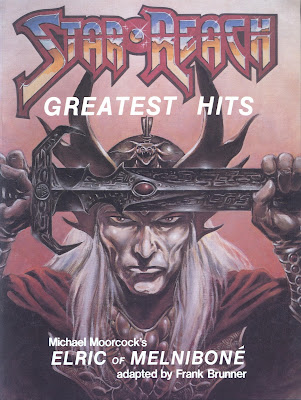













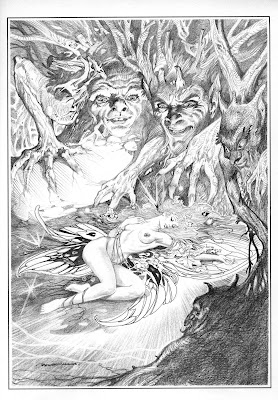

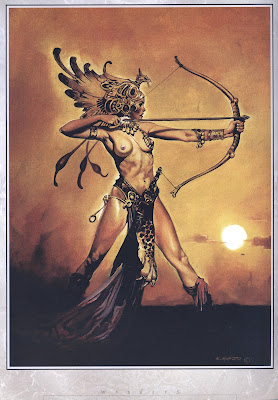








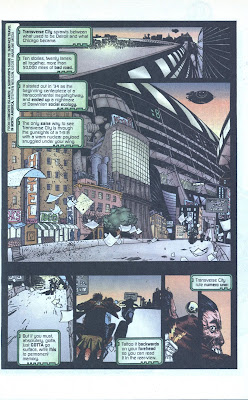
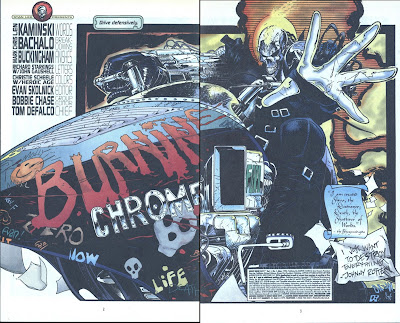





















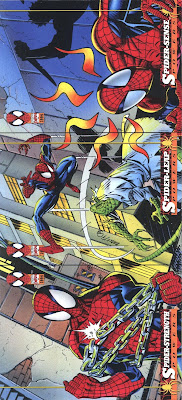


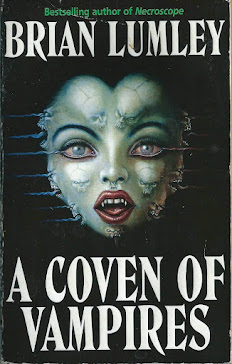






.jpg)
















